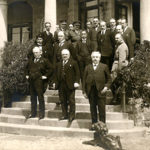Published June 30, 2011
2011 Moscow Demographic Summit
For complete coverage of the 2011 Moscow Demographic Summit, visit the Demographic Research Institute (Moscow) homepage. A PDF of Mr. Mueller’s remarks is available at the link above. The accompanying powerpoint is available here.
At the last two World Congresses of Families in Warsaw[1] and Amsterdam[2], I presented a country-by-country model of fertility, which has since been published in my book Redeeming Economics. At this 2011 Moscow Demographic Summit, I’d like to update that analysis to discuss “Babies and Dollars: Implications for USA, Russia, and the World,” drawing on a recent article in The Family in America.[3] But since several Russian officeholders and experts are associated with this summit, I will close by suggesting briefly that it is in the interest of all major countries including Russia to co-operate in ending the dollar’s role as chief official reserve currency.

As Touchstone Magazine’s publisher Jim Kushiner noted yesterday, the Parable of the Good Samaritan epitomizes the Bible’s Second Great Commandment to “love your neighbor as yourself.” But its lesson transcends nationality and religion. The cover of my book features Gustave Dore’s engraving, “Arrival of the Good Samaritan at the Inn” because the parable illustrates all the possible economic transactions we can have with our fellow man: the robbers beating a man and leaving him for dead illustrates crime; the priest and Levite who passed him by illustrate indifference; the innkeeper’s bargain with the Samaritan illustrates justice in exchange; and finally, the Samaritan’s devotion of time and money to restore the beaten man to life illustrates a gift. Crime, indifference, just exchange, and gift: this is the range of possible transactions.

In contrast, the premise of today’s neoclassical economic theory was expressed by Adam Smith in the Wealth of Nations with his assumption that “every individual . . . intends only his own gain.”[4] What I call “neoscholastic” economics differs from neoclassical economics chiefly in retaining Augustine and Aristotle’s theory of gifts (and crimes) as well as exchanges. This also makes the neoscholastic theory much more accurate.

For example, updating scholastic theory refutes the famous claim by economist Steven D. Levitt, featured in Freakonomics, that the U.S. Supreme Court’s legalization of abortion in 1973 caused the crime rate to fall 15-20 years later, by eliminating potential criminals. In fact, there is a 90% inverse relation between economic fatherhood and homicide.
The “Neoscholastic” fertility model is also more accurate. Just four factors explain most variation in birth rates among the 70 countries for which sufficient data are available (comprising only about one-third of all countries, but more than three-quarters of world population).[5] The birth rate is strongly and about equally inversely proportional to per capita social benefits and per capita national saving (both adjusted for differences in purchasing power), which represent provision by current adults for their own well-being.


When these factors are taken into account, a legacy of totalitarian government is also highly significant in reducing the birth rate, by about 0.6 children per couple.
Finally, the birth rate is strongly and positively related to the rate of weekly worship. This is because all gifts of scarce resources—whether rearing a child or worship—require the same lowering of self and raising of others in our scale of preferences for persons.

But regular worship is not only positively related to fertility in a roughly linear fashion. It is also inversely related to the incidence of abortion, which (like crime in general) rises exponentially as the rate of worship declines.[6]

There are four main reasons, then, for “demographic winter,” in order of importance: First, low rates of religious observance, which are associated with low birth rates and high incidence of abortion; second, social benefits so high as to displace gifts within the family, particularly the gift of life; third, legacies of totalitarianism; and finally, finally, heavy reliance on so-called “consumption” taxes, which penalize investment in “human capital.”

If legal abortion continues and social benefits double as a share of U.S. national income, as now projected, the U.S. Total Fertility Rate will likely fall in coming decades from the current replacement rate of 2.1 to less than 1.7.

As I showed more than ten years ago, the entire prospective imbalance in the U.S. pay-as-you-go Social Security retirement pension system is due to the decline in the ratio of workers to beneficiaries caused by legal abortion.

But the same is true of other countries. Demographer Igor Beloborodov told us yesterday that Bolshevik legalization of abortion in 1918 has reduced Russian population by 240-270 million people. That reduction approximates the size of the USA today, the world’s third most populous country. Fifty years ago and today, the three most populous countries were China, India, and the United States. But the practice of abortion in China but not as widely in India is causing a reversal of their first and second population ranks.
Even with the negative impact from projected expansion of U.S. social benefits, if legal abortion were ended the birth rate would rise and remain above the replacement rate indefinitely in the USA, and “demographic winter” would be reversed in most other countries. (For example, adjusted for differences in mortality rates, in 2006 China’s TFR was 1.53 after but 2.10 before abortions; India’s 2.34 after and 2.41 before abortions, the USA 2.01 after but 2.66 before abortions; and Russia’s TFR was only 1.29 after, but 3.08 before abortions.[7] Based on all 52 countries for which data are available (comprising about two-thirds of world population), the World TFR in 2006 was 1.88 after, but 2.34 before abortions.

I would like to close with a final word about faulty monetary policy, which goes beyond demography: Some American officials believe that the dollar’s role as chief official reserve currency has strengthened the United States. As Lewis E. Lehrman and I have shown, the reverse is true. The U.S. international investment position-American investments minus foreign liabilities-has declined almost exactly by the amount of U.S. public debt borrowed from foreign monetary authorities. The same would happen to any other country’s currency which aspired to displace the dollar as pre-eminent official reserve currency, as the dollar displaced the pound sterling.

Moreover, the expansion and contraction of foreign official dollar reserves caused the crisis of 2007-09.
Therefore, ending the U.S. dollar’s role as chief official reserve currency, by repaying past borrowing from foreign monetary authorities and restoring the international gold standard is in the strategic interests of USA and other countries including Russia.[8]
As an economist I practice what has been called the ‘dismal science.’ But my message is one of hope. All the unfavorable trends we have discussed here at the Moscow Demographic Summit are reversible if we reverse the policies which caused them.
John D. Mueller is the Lehrman Institute Fellow in Economics at the Ethics and Public Policy Center.
(1) John D. Mueller, “A Family-Friendly Fiscal Policy to Weather Demographic Winter,” remarks to the Fourth World Congress of Families, Warsaw, Poland, 11 May 2007, http:/ /www.worldcongress.org/wcf4.spkrs/wcf4.mueller.htm and http://www.eppc-stage.local/publications/pubID.2937/pub_detail.asp.
(2) John D. Mueller, “How Do Nations Choose ‘Demographic Winter’? Is America Doing So?” Remarks at the Fifth World Congress of Families Panel on “Family and Demography,” Amsterdam, Netherlands, 11 August 2009, http://www.worldcongress.org/wcf5.spkrs/wcf5.mueller.htm and http://www.eppc-stage.local/publications/pubID.3911/pub_detail.asp
(3) I’d like to thank Mary Claire Reim for her assistance in gathering the data necessary to update the model. A longer version of the article on which these remarks are based may be found in The Family in America at http://www.familyinamerica.org/index.php?doc_id=28&cat_id=13 and http://www.eppc-stage.local/programs/economics/publications/programID.41,pubID.4500/pub_detail.asp
(4) Smith, A. (1966 [1776], Smith, Wealth of Nations, IV.ii.9, accessed on 19 September 2009 from http://www.econlib.org/library/Smith/smWN13.html #IV.2.9.
(5) John D. Mueller, “How Does Fiscal Policy Affect the American Worker?” Notre Dame Journal of Law, Ethics and Public Policy Vol. 20 No. 2 (Spring 2006), 563-619; available at http://www.eppc-stage.local/publications/pubID.2671/pub_detail.asp
(6) As Augustine noted, a crime is the opposite of a gift: the taking from other persons their own goods. As with “legal” abortion, the objective facts remain the same whether or not the crime is recognized as such by human law. Augustine,On Christian Doctrine3. 10. 16 (Grand Rapids: Christian Classics Ethereal Library), pp. 396-97, http://www.ccel.org/ccel/augustine/doctrine.xi_2.html.
(7) Fertility rates should be adjusted for differences in mortality rates. The Net Reproduction Rate (NRR) represents a hypothetical woman whose experience matches the average rates of fertility and death of all women in a given year. An NRR of 1.00 indicates that each woman bears exactly one surviving daughter. The Total Fertility Rates used in the model equals twice the NRR. For example, the TFR in Mali in 2006 was 7.42, but the NRR was 1.987, which corresponds to a TFR of 3.97 children per couple. In other words, in Mali the typical couple had about 3-1/2 children simply to compensate for the likelihood of premature death before reaching child-bearing age.
(8) A more complete presentation of the monetary ideas may be found at http://www.thegoldstandardnow.org/key-blogs/207-next-president-end-reserve-currency and http://www.eppc-stage.local/programs/economics/publications/programID.41,pubID.4426/pub_detail.asp.








